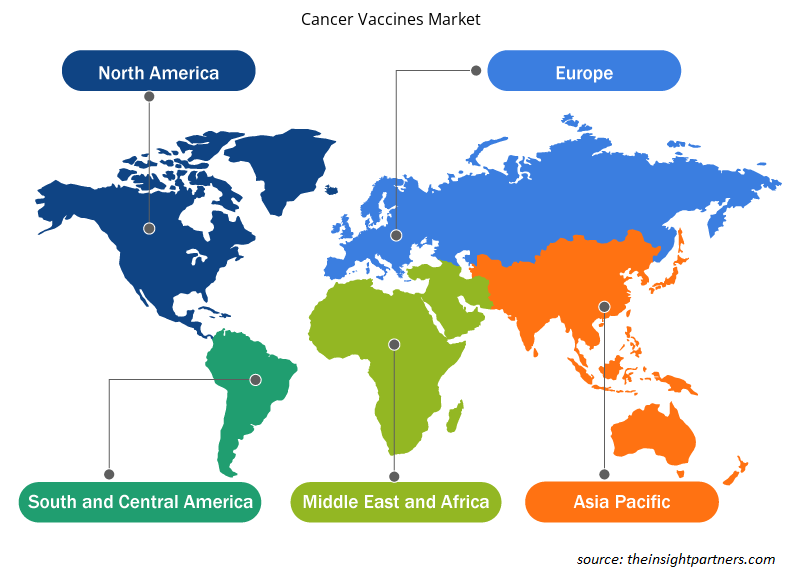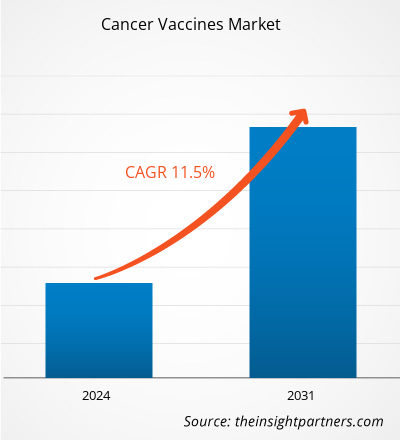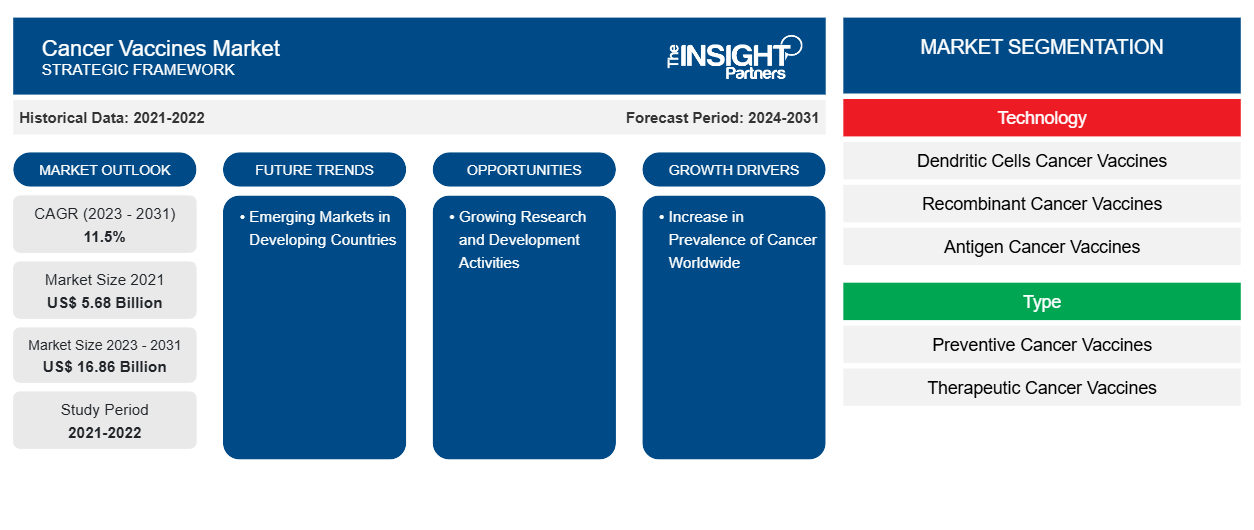Se estimó que el mercado de vacunas contra el cáncer sería de 5.680 millones de dólares estadounidenses en 2021 y de xx.000 millones de dólares estadounidenses en 2023. Se espera que alcance los 16.860 millones de dólares estadounidenses en 2031 y registre una CAGR del 11,5 % hasta 2031. El desarrollo de vacunas contra el cáncer personalizadas, el enfoque en terapias combinadas y el aumento de las inversiones en actividades de investigación y desarrollo de vacunas contra el cáncer probablemente seguirán siendo tendencias clave en el mercado de vacunas contra el cáncer.Bn in 2021 and US$ xx Bn in 2023. It is expected to reach US$ 16.86 Bn by 2031 and record a CAGR of 11.5% until 2031. Developing personalized cancer vaccines, focusing on combination therapies, and growing investments in cancer vaccine research and development activities will likely remain key cancer vaccines market trends.
Análisis del mercado de vacunas contra el cáncer
Se espera que la creciente incidencia del cáncer en todo el mundo impulse el crecimiento del mercado de vacunas contra el cáncer. El cáncer es una de las principales causas de muerte en todo el mundo y está afectando profundamente la calidad de vida. Por lo tanto, el cáncer sería una carga para la sociedad si no se diagnostica y trata a tiempo. Según el informe de la Organización Mundial de la Salud, hubo alrededor de 19.976.499 casos de cáncer en 2022; se estima que el número de casos de cáncer alcanzará los 32,6 millones en 2045.
La creciente prevalencia del cáncer en diferentes regiones del mundo está incrementando la demanda mundial de vacunas contra el mismo.
Panorama del mercado de vacunas contra el cáncer
El mercado mundial de vacunas contra el cáncer está segmentado por regiones en América del Norte, Europa, Asia Pacífico, Oriente Medio y África, y América del Sur y Central. Se espera que el mercado crezca en esta región debido a factores como el aumento de la prevalencia del cáncer en todo el mundo, las iniciativas adoptadas por las organizaciones de investigación sanitaria mundial y los actores clave en materia de vacunas contra el cáncer. Sin embargo, se espera que un menor número de vacunas disponibles comercialmente para el tratamiento del cáncer y el alto costo de las vacunas obstaculicen el crecimiento del mercado hasta cierto punto durante los años de pronóstico.
Personalice este informe según sus necesidades
Obtendrá personalización en cualquier informe, sin cargo, incluidas partes de este informe o análisis a nivel de país, paquete de datos de Excel, así como también grandes ofertas y descuentos para empresas emergentes y universidades.
-
Obtenga las principales tendencias clave del mercado de este informe.Esta muestra GRATUITA incluirá análisis de datos, desde tendencias del mercado hasta estimaciones y pronósticos.
Factores impulsores y oportunidades del mercado de vacunas contra el cáncer
Iniciativas adoptadas por organizaciones mundiales de investigación en salud y actores clave para las vacunas contra el cáncer para favorecer el mercado.
Las frecuentes iniciativas y lanzamientos gubernamentales impulsan el mercado de vacunas. En febrero de 2024, el gobierno de la India lanzó una nueva iniciativa en la que se incluirá a las niñas de entre 9 y 14 años en el Programa de Inmunización Universal contra el VPH (UIP, por sus siglas en inglés). Se trata de un paso importante para garantizar una mayor accesibilidad y asequibilidad de la vacuna.
Mercados emergentes: una oportunidad en el mercado de vacunas contra el cáncer
Los países en desarrollo de Asia y el Pacífico están creando mejores oportunidades de expansión comercial para los principales actores del mercado. La mayoría de estos actores se centran en mercados emergentes como India y China debido a un gran número de pacientes con cáncer y al creciente turismo médico en estos países. Según el Consejo de Viajes Sanitarios de Malasia, en 2022, más de 850.000 viajeros sanitarios visitaron Malasia por diversos motivos. El bajo coste de las cirugías y la disponibilidad de tecnologías avanzadas para los procedimientos, con menos tiempo de espera, están atrayendo a personas de todo el mundo hacia estos países en desarrollo para procedimientos médicos, incluida la detección del cáncer. La creciente incidencia del cáncer está creando oportunidades en el mercado. Por ejemplo, en 2022, se registraron ~1.413.316 nuevos casos de cáncer en la India. Por tanto, la escalada del turismo médico y la creciente prevalencia del cáncer en los países emergentes están proporcionando importantes oportunidades de crecimiento a los actores que operan en el mercado.
Análisis de segmentación del informe de mercado de vacunas contra el cáncer
Los segmentos clave que contribuyeron a la derivación del análisis del mercado de vacunas contra el cáncer son los servicios y las aplicaciones.
- Según la tecnología, el mercado de vacunas contra el cáncer se segmenta en vacunas contra el cáncer de células dendríticas, vacunas contra el cáncer recombinantes, vacunas contra el cáncer de antígenos, vacunas contra el cáncer de células enteras y vacunas contra el cáncer de vectores virales. El segmento de vacunas contra el cáncer recombinantes tuvo la mayor participación del mercado en 2023, y se prevé que el mismo segmento registre la CAGR más alta del mercado durante el período de pronóstico.
- Por tipo, el mercado de vacunas contra el cáncer se segmenta en vacunas preventivas contra el cáncer y vacunas terapéuticas contra el cáncer. El segmento de vacunas preventivas contra el cáncer tuvo la mayor participación del mercado en 2023, y se prevé que el mismo segmento registre la CAGR más alta del mercado durante el período de pronóstico.
- Por indicación, el mercado de vacunas contra el cáncer se segmenta en cáncer de cuello uterino, cáncer de próstata y otras indicaciones. El segmento de cáncer de cuello uterino tuvo la mayor participación del mercado en 2023, y se prevé que el mismo segmento registre la CAGR más alta del mercado durante el período de pronóstico.
- El mercado de vacunas contra el cáncer se ha segmentado por usuario final en pediatría y adultos. El segmento pediátrico tuvo la mayor participación del mercado en 2023, y se estima que el mismo segmento registrará la CAGR más alta del mercado durante el período de pronóstico.
Análisis de la cuota de mercado de las vacunas contra el cáncer por geografía
El alcance geográfico del informe del mercado de vacunas contra el cáncer se divide principalmente en cinco regiones: América del Norte, Asia Pacífico, Europa, Medio Oriente y África, y América del Sur/América del Sur y Central.
América del Norte incluye a Estados Unidos, Canadá y México. El mercado de América del Norte tuvo una participación significativa en el mercado global durante el año 2023. Se prevé que la demanda del mercado en la región experimente un crecimiento a un ritmo significativo durante el período de pronóstico debido a varios factores, como la creciente necesidad de diagnosticar y tratar el cáncer, la creciente incidencia del cáncer, el alto gasto en I+D, la creciente competencia entre los actores del mercado y las subvenciones gubernamentales para que los institutos de investigación desarrollen nuevos tratamientos son algunos de los factores destacados que impulsan el crecimiento del mercado.
La región de Asia y el Pacífico es el mercado de vacunas contra el cáncer que crece más rápidamente a nivel mundial, debido al creciente desarrollo de vacunas contra el cáncer en países como Japón y China. La gran población de pacientes con cáncer, el creciente número de estudios de investigación, el creciente apoyo gubernamental y el creciente número de empresas emergentes y de biotecnología en esta región son factores que crean oportunidades de crecimiento para el mercado.
Perspectivas regionales del mercado de vacunas contra el cáncer
Los analistas de Insight Partners explicaron en detalle las tendencias y los factores regionales que influyen en el mercado de vacunas contra el cáncer durante el período de pronóstico. Esta sección también analiza los segmentos y la geografía del mercado de vacunas contra el cáncer en América del Norte, Europa, Asia Pacífico, Oriente Medio y África, y América del Sur y Central.

- Obtenga datos regionales específicos para el mercado de vacunas contra el cáncer
Alcance del informe sobre el mercado de vacunas contra el cáncer
| Atributo del informe | Detalles |
|---|---|
| Tamaño del mercado en 2021 | 5.680 millones de dólares estadounidenses |
| Tamaño del mercado en 2031 | US$ 16.86 mil millones |
| CAGR global (2023 - 2031) | 11,5% |
| Datos históricos | 2021-2022 |
| Período de pronóstico | 2024-2031 |
| Segmentos cubiertos |
Por tecnología
|
| Regiones y países cubiertos |
América del norte
|
| Líderes del mercado y perfiles de empresas clave |
|
Densidad de actores del mercado de vacunas contra el cáncer: comprensión de su impacto en la dinámica empresarial
El mercado de vacunas contra el cáncer está creciendo rápidamente, impulsado por la creciente demanda de los usuarios finales debido a factores como la evolución de las preferencias de los consumidores, los avances tecnológicos y una mayor conciencia de los beneficios del producto. A medida que aumenta la demanda, las empresas amplían sus ofertas, innovan para satisfacer las necesidades de los consumidores y aprovechan las tendencias emergentes, lo que impulsa aún más el crecimiento del mercado.
La densidad de actores del mercado se refiere a la distribución de las empresas o firmas que operan dentro de un mercado o industria en particular. Indica cuántos competidores (actores del mercado) están presentes en un espacio de mercado determinado en relación con su tamaño o valor total de mercado.
Las principales empresas que operan en el mercado de vacunas contra el cáncer son:
- CSL limitada
- ADURO BIOTECNOLOGÍA INC.
- Compañía farmacéutica Astellas Inc.
- Merck & Co. Inc.
- Sanofi
- Compañía Bristol-Myers Squibb
Descargo de responsabilidad : Las empresas enumeradas anteriormente no están clasificadas en ningún orden particular.

- Obtenga una descripción general de los principales actores clave del mercado de vacunas contra el cáncer
Noticias y novedades sobre el mercado de vacunas contra el cáncer
El mercado de vacunas contra el cáncer se evalúa mediante la recopilación de datos cualitativos y cuantitativos posteriores a la investigación primaria y secundaria, que incluye publicaciones corporativas importantes, datos de asociaciones y bases de datos. A continuación, se incluye una lista de los avances en el mercado de vacunas contra el cáncer y las estrategias:
- En diciembre de 2023, los hospitales de la Universidad de Oxford lanzaron un nuevo ensayo de vacuna de ARNm contra el cáncer para pacientes con cáncer de cabeza y cuello. (Fuente: Comunicado de prensa de la empresa)
-
En febrero de 2024, comienza el ensayo de la vacuna contra el cáncer de Moderna, denominada mRNA-4359, en el Imperial College Healthcare NHS Trust. El ensayo busca evaluar la seguridad y la posible eficacia de la terapia en el tratamiento del melanoma, el cáncer de pulmón y otros cánceres con tumores sólidos
(Fuente: Comunicado de prensa de la empresa)
Informe sobre el mercado de vacunas contra el cáncer: cobertura y resultados
El informe “Tamaño y pronóstico del mercado de vacunas contra el cáncer (2021-2031)” proporciona un análisis detallado del mercado que cubre las siguientes áreas:
- Tamaño del mercado y pronóstico a nivel global, regional y nacional para todos los segmentos clave del mercado cubiertos bajo el alcance
- Dinámica del mercado, como impulsores, restricciones y oportunidades clave
- Principales tendencias futuras
- Análisis detallado de las cinco fuerzas de Porter y PEST y FODA
- Análisis del mercado global y regional que cubre las tendencias clave del mercado, los principales actores, las regulaciones y los desarrollos recientes del mercado.
- Análisis del panorama de la industria y de la competencia que abarca la concentración del mercado, el análisis de mapas de calor, los actores destacados y los desarrollos recientes
- Perfiles detallados de empresas
- Análisis histórico (2 años), año base, pronóstico (7 años) con CAGR
- Análisis PEST y FODA
- Tamaño del mercado, valor/volumen: global, regional y nacional
- Industria y panorama competitivo
- Conjunto de datos de Excel
Informes recientes
Informes relacionados
Testimonios
Razón para comprar
- Toma de decisiones informada
- Comprensión de la dinámica del mercado
- Análisis competitivo
- Información sobre clientes
- Pronósticos del mercado
- Mitigación de riesgos
- Planificación estratégica
- Justificación de la inversión
- Identificación de mercados emergentes
- Mejora de las estrategias de marketing
- Impulso de la eficiencia operativa
- Alineación con las tendencias regulatorias























 Obtenga una muestra gratuita para - Mercado de vacunas contra el cáncer
Obtenga una muestra gratuita para - Mercado de vacunas contra el cáncer